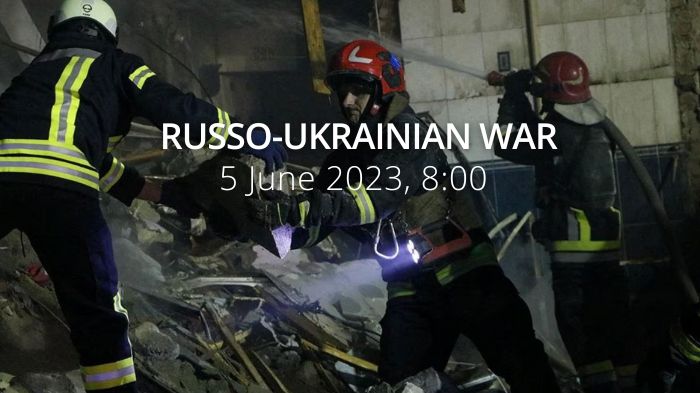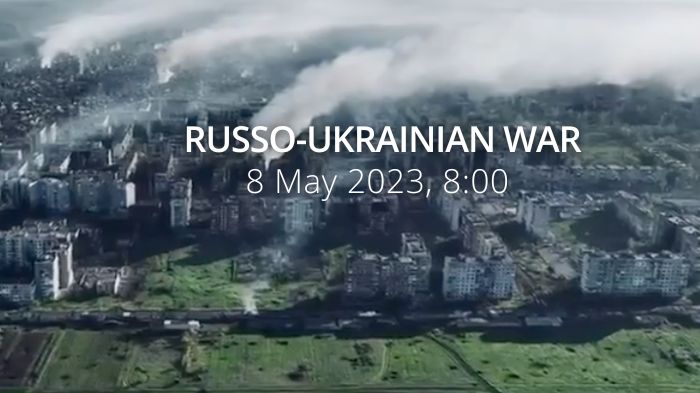Daily overview — Summary report, October 20
A map of the approximate situation on the ground in Ukraine as of 00:00 UTC 05/07/22. pic.twitter.com/Cg5RdVg18W
— War Mapper (@War_Mapper) July 5, 2022
The General Staff’s operational update regarding the Russian invasion as of 06.00 am, October 20, 2022 is in the dropdown menu below
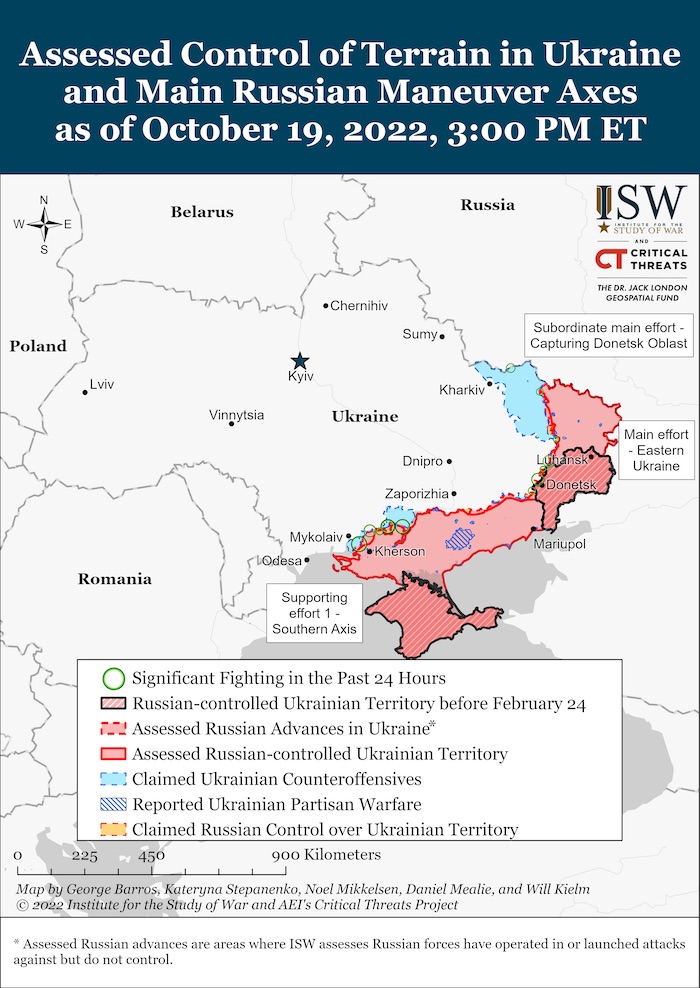
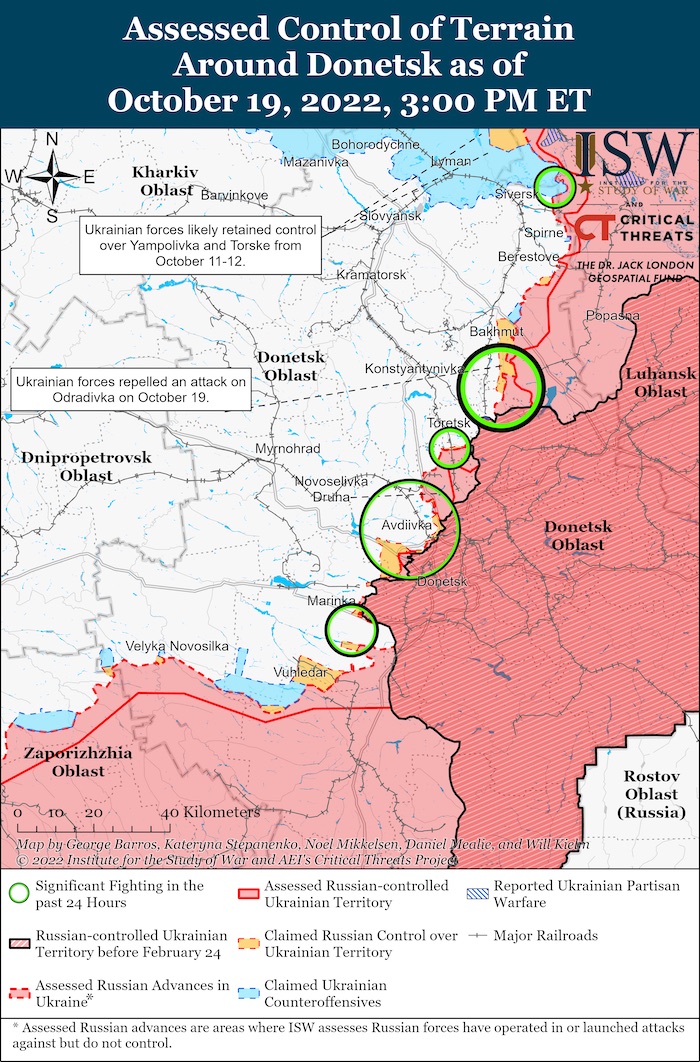
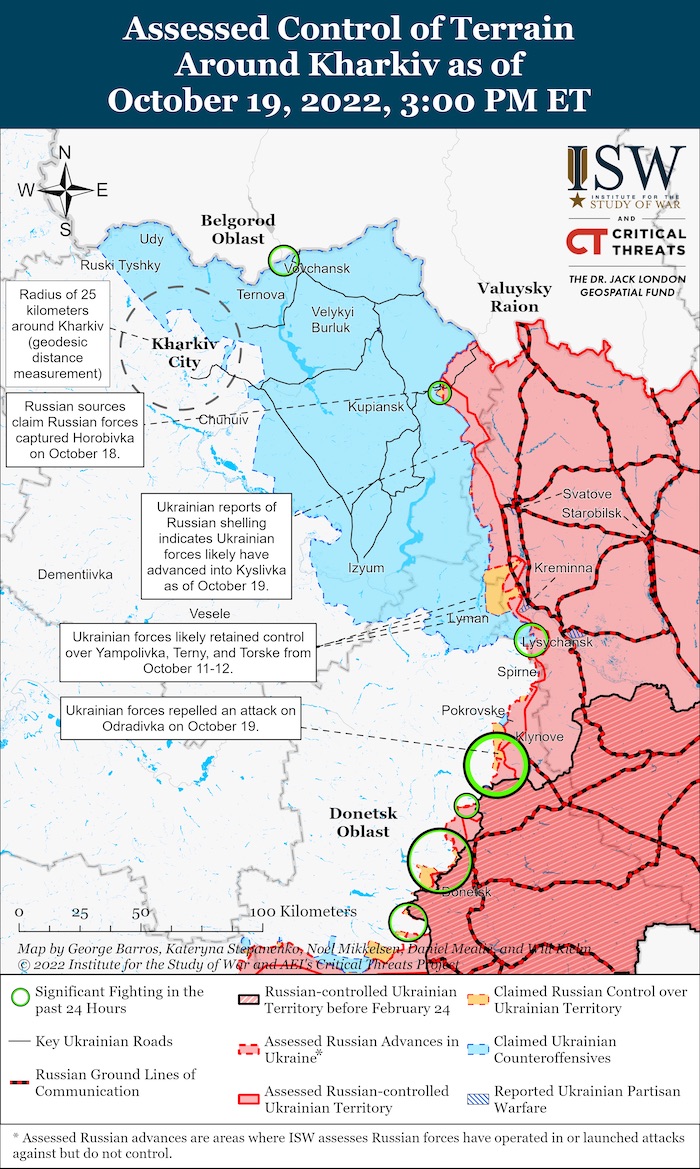
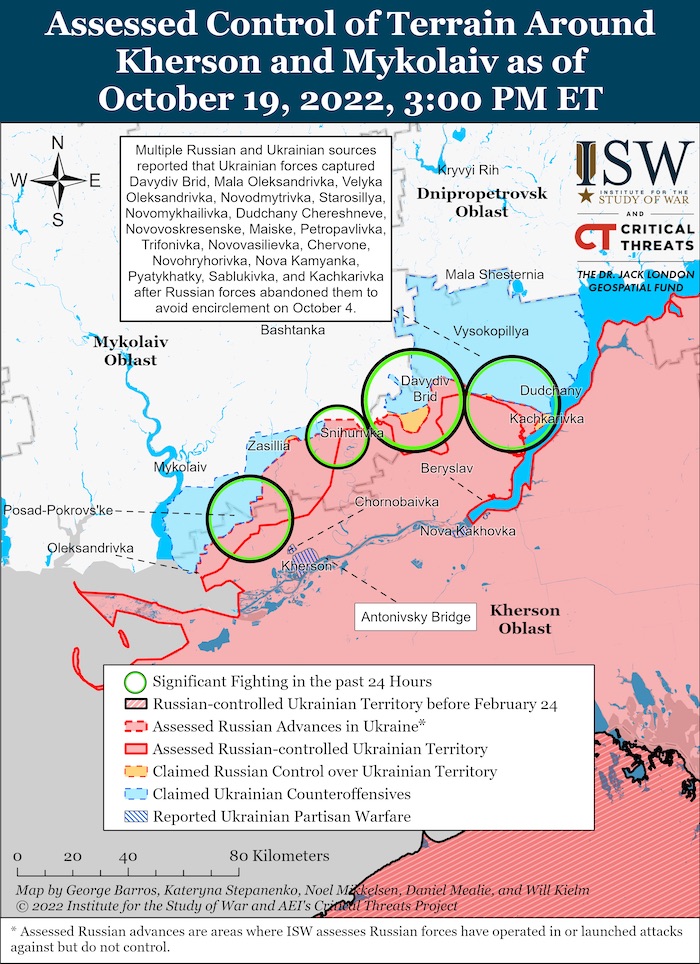
Military Updates
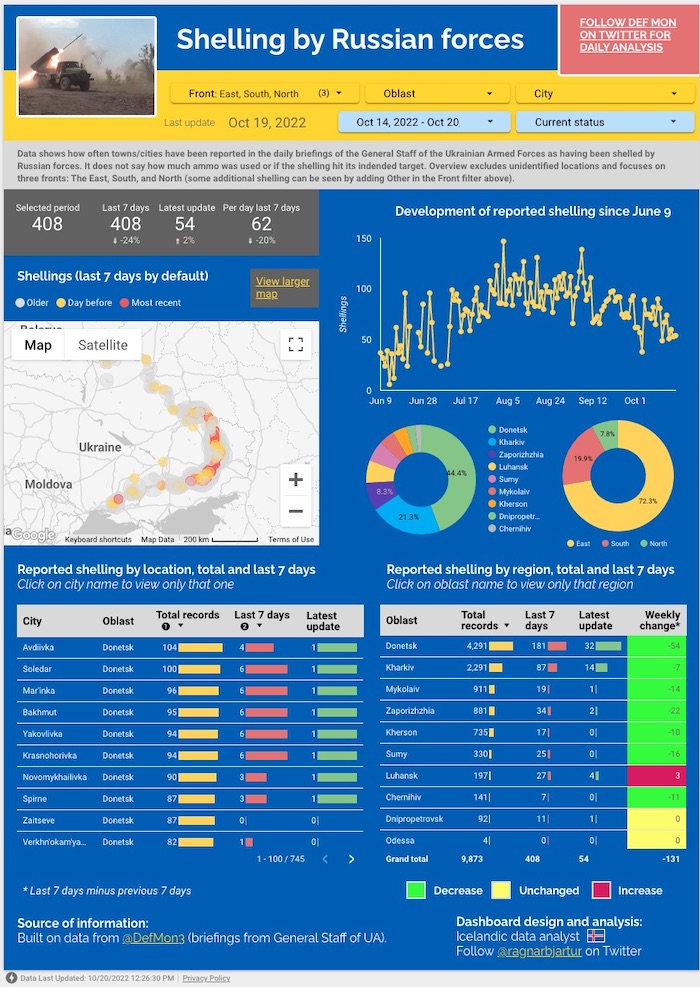
https://twitter.com/ukraine_world/status/1582731027843194880
https://twitter.com/EuromaidanPress/status/1582801253456920584
https://twitter.com/EuromaidanPress/status/1582650138409205760
Regional Updates
https://twitter.com/EuromaidanPress/status/1582688140892188674
In Chernihiv Oblast, as a result of strikes by kamikaze drones, 3 injured.
https://twitter.com/EuromaidanPress/status/1582719828179050496
- The so-called “governors” will receive additional powers to ensure security in the regions.
- Response measures under martial law will be determined by the “heads of the D/LNR”, Zaporizhzhia and Kherson Oblasts.
- It was “the Ukrainian special services that organized the explosion on the Crimean bridge.”
- The Kyiv “regime refused to negotiate,” continues to shell “new Russian territories” using “terrorist methods.”
https://twitter.com/EuromaidanPress/status/1582705472762937344
According to British Defence Intelligence, (last 48 hours):
- On 18 October 2022, recently appointed commander of Russian forces in Ukraine, General Sergei Surovikin, told Russian media that ‘a difficult situation has emerged’ in the Kherson area. He endorsed the previously announced plans of the occupation authorities to evacuate the civilian population.
- As the overall operational commander, Surovikin’s announcement highlighting negative news about the ‘special military operation’ is highly unusual. It likely indicates that the Russian authorities are seriously considering a major withdrawal of their forces from the area west of the Dnipro river.
- A key challenge of any Russian withdrawal operation would be extracting troops and their equipment across the 1000m wide river in good order. With all the permanent bridges severely damaged, Russia would highly likely rely heavily on a temporary barge bridge it completed near Kherson in recent days, and military pontoon ferry units, which continue to operate at several locations.
Losses of the Russian army
As of 20 October, the approximate losses of weapons and military equipment of the Russian Armed Forces from the beginning of the war to the present day:
https://twitter.com/MFA_Ukraine/status/1583002296124067840
Humanitarian
https://twitter.com/EuromaidanPress/status/1582793707564285969
Environmental
Russia keeps destroying Ukrainian energy and heating infrastructure: Russian attacks caused fire at Burshtyn thermal power plant in Ivano-Frankivsk Oblast – Regional Head Svitlana Onyshchuk
The fire was quickly extinguished.https://t.co/nWaFq1sATt, https://t.co/mxdN4au4e1
— Euromaidan Press (@EuromaidanPress) October 19, 2022
Legal
Russia's attacks on Ukrainian cities are war crime – Greek FM
He said it at a joint briefing with his Ukrainian counterpart, Dmytro Kuleba, in Kyiv.https://t.co/v8lOamCngv
— Euromaidan Press (@EuromaidanPress) October 19, 2022
Support
EU ambassadors approve sanctions against Iran for its part in war against Ukraine – Interfax Ukraine citing diplomatic source
The decision is expected to be formally approved by a written procedure followed by publication on 20 October.https://t.co/SnZk4z9KzA
— Euromaidan Press (@EuromaidanPress) October 19, 2022
New Developments
EU plans to impose sanctions on Iranian individuals & legal entities due to weapons supply to Russia, which is used to target Ukrainian civilian & energy infrastructure – Politico
One senior official said the new package sent a "strong signal" to Tehran.https://t.co/QwF513oSSy
— Euromaidan Press (@EuromaidanPress) October 19, 2022
The people of Ukraine win EU Parliament’s 2022 Sakharov prize
The EU Parliament has awarded its annual human rights Sakharov Prize to the "brave people of Ukraine, represented by their President, elected leaders, and civil society."https://t.co/GPj9aMjooY
— Euromaidan Press (@EuromaidanPress) October 19, 2022
Assessment
- On the war.
The Institute for the Study of War has made the following assessment as of 19 October, 2022:
Russian authorities are likely setting information conditions to justify planned Russian retreats and significant territorial losses in Kherson Oblast. Commander of Russian Armed Forces in Ukraine Army General Sergey Surovikin reported during an appearance on Russian television that the Russian military leadership has to make “difficult decisions” regarding Kherson Oblast and accused Ukraine of planning to strike civilian and residential infrastructure in Kherson Oblast.[1] Kherson Occupation Head Vladimir Saldo relatedly noted that his administration is evacuating the west bank of the Dnipro River in anticipation of a “large-scale” Ukrainian offensive.[2] Surovikin‘s and Saldo’s statements are likely attempts to set information conditions for a full Russian retreat across the Dnipro River, which would cede Kherson City and other significant territory in Kherson Oblast to advancing Ukrainian troops. Russian military leaders have evidently learned from previous informational and operational failures during the recent Ukrainian counteroffensive in Kharkiv Oblast and are therefore likely attempting to mitigate the informational and operational consequences of failing to defend against another successful Ukrainian advance.
Russian forces are also setting information conditions to conduct a false-flag attack on the Kakhovka Hydroelectric Power Plant (HPP). The Russian military may believe that breaching the dam could cover their retreat from the right bank of the Dnipro River and prevent or delay Ukrainian advances across the river. Surovikin claimed on October 18 that he has received information that Kyiv intends to strike the dam at the Kakhovka Hydroelectric Power Plant (HPP), which he alleged would cause destructive flooding in Kherson Oblast.[3] Saldo echoed this claim and warned that Ukrainian forces intend to strike dams upstream of Kherson City.[4] Russian authorities likely intend these warnings about a purported Ukrainian strike on the Kakhovka HPP to set information conditions for Russian forces to damage the dam and blame Ukraine for the subsequent damage and loss of life, all while using the resulting floods to cover their own retreat further south into Kherson Oblast. The Kremlin could attempt to leverage such a false-flag attack to overshadow the news of a third humiliating retreat for Russian forces, this time from western Kherson. Such an attack would also further the false Russian information operation portraying Ukraine as a terrorist state that deliberately targets civilians.
Russia continues to use the guise of civilian “evacuations” as a cover for the mass forced removal of civilians from Russian-occupied areas of Ukraine. Saldo’s announcement of a mass withdrawal from the west bank of the Dnipro River is likely intended in part to evacuate Russian occupation officials, collaborators, and other occupation organs in anticipation of imminent Ukrainian advances, but Russian officials are likely also using the façade of humanitarian necessity to deport large populations of Ukrainians to Russia, as ISW has previously reported. Russia does not appear to reap any economic benefits from resettling tens of thousands of unwilling Ukrainians in Russia, suggesting that the purpose of such removals is both to damage Ukraine’s long-term economic recovery as it retakes its territory and, more importantly, to support Russia’s ethnic cleansing campaign, which is attempting to eradicate the Ukrainian ethnicity and culture.[5] The Russians may also intend to press “evacuated” Ukrainians into their armed forces, offsetting the losses and failures of the partial mobilization.
Russian President Vladimir Putin’s October 19 declaration of martial law readiness is largely legal theater meant to legitimize activities the Russian military needs to undertake or is already undertaking while creating a framework for future mobilization and domestic restrictions.[6] Putin declared varying levels of “martial law readiness” across Russia and in Russian-occupied Ukrainian territories. These declarations outline four levels of readiness, ranging from “maximum” (full-scale martial law in Russian-occupied Kherson, Zaporizhzhia, Donetsk and Luhansk oblasts) to “basic” (across all of Russia).[7]
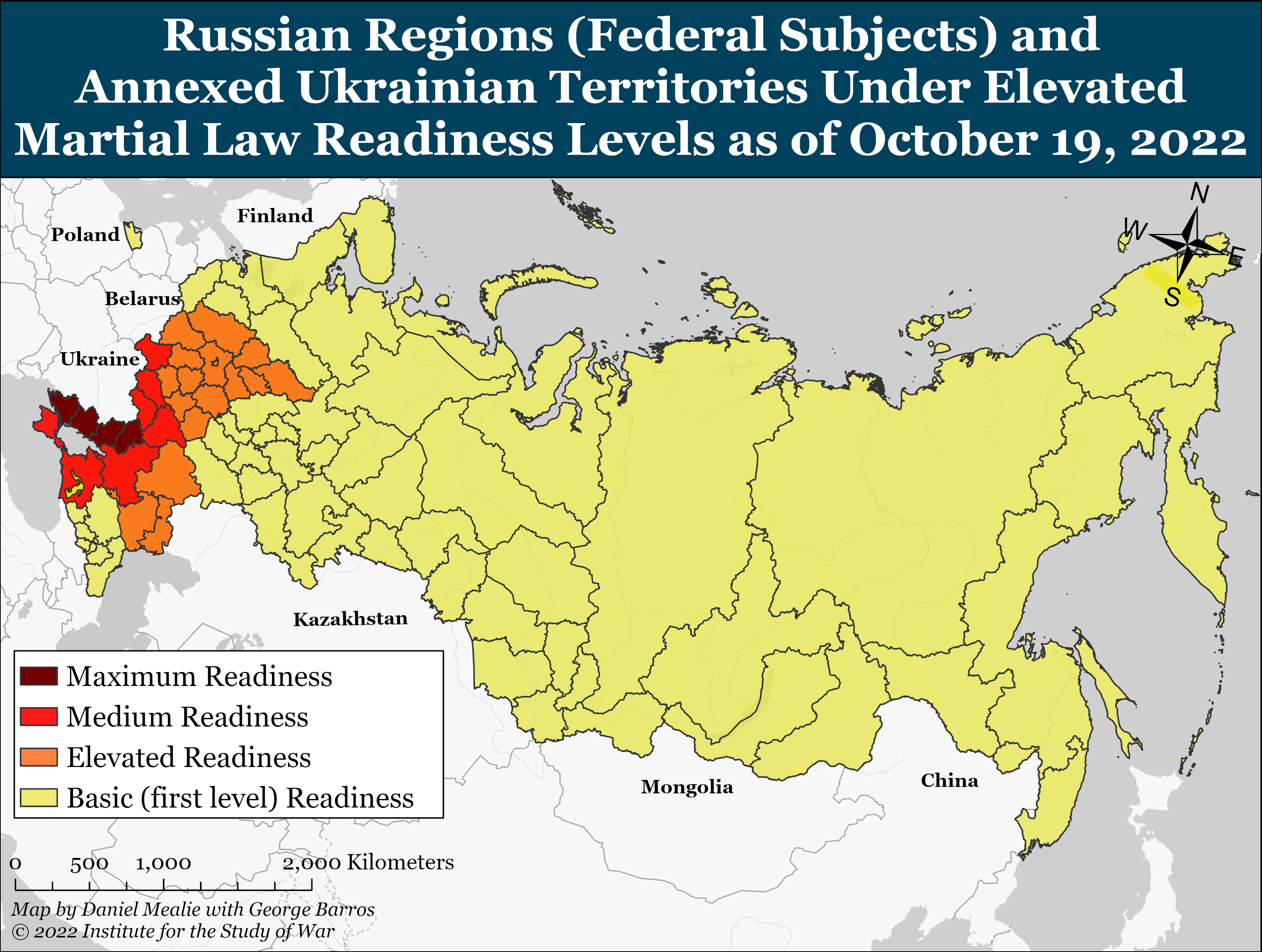
Putin did not formally declare martial law outside of Kherson, Zaporizhzhia, Donetsk, and Luhansk oblasts, but instead directed areas outside Ukraine to build out the legal framework necessary to support Russian mobilization.[8] Putin’s speech framed the declaration of martial law in four Russian-occupied parts of Ukraine as a continuation of the wartime status quo, adjusted to Russian legal frameworks after Russia’s illegal annexation of those territories.[9] Putin’s decree did not spell out immediate next steps under martial law or elevated readiness levels but granted sweeping emergency powers to regional governors and gave local authorities until October 22 to develop and submit specific proposals for those next steps. Additional information will become apparent as regional governors and law enforcement submit and implement those proposals, which will likely be directed at least in part by the Kremlin but laundered through local authorities. Putin also left himself a path to expand his declarations of martial law, noting that “If necessary, in the Russian Federation during the period of martial law, other measures provided for by the [federal law covering martial law] may be applied.”[10] That language leaves open the door for future declarations and expansions of government authorities.
Putin’s decrees identified several sectors in which the Russian state will be exerting increasing control:
- In areas of maximum and medium readiness, the decree calls for unspecified “mobilization measures in the economic sphere,” likely to provide economic and industrial support to Putin’s so-called “partial” mobilization of at least 300,000 Russian men.
- In all areas, the decree makes provisions for government control of transportation and communications infrastructure as well as increased security around government buildings and other critical infrastructure.
- In areas of maximum application of martial law (Russian-occupied Kherson, Zaporizhzhia, Donetsk, and Luhansk), the decree calls for the establishment of “territorial defense” headquarters with unspecified roles.
- In areas of medium and elevated readiness, the decree enables regional leaders to take measures for territorial defense and civil defense.
- In areas of medium readiness, the decree enables governments to forcibly “temporarily resettle” civilians.
- The decree also includes vague language for each category, authorizing local authorities to “implement measures to meet the needs of the Armed Forces of the Russian Federation, other troops, military formations, bodies and needs of the population.” Such language could be used to legalize almost any government action.
- In areas of elevated, medium, and maximum readiness, the decree allows for restricting movements of people and vehicles. Russian Deputy Foreign Minister Yevgeny Ivanov claimed on October 19 that the government does not currently intend to restrict movement out of the country.[11] However, Putin’s decree would likely provide legal cover for the implementation of such restrictions without passing additional decrees.
These moves closer to full-scale martial law are unsurprising but disordered—a competent modern military should implement economic mobilization, secure lines of transportation, and coordinate territorial defense before or as initial mobilization for war begins, not as follow-on reserve mobilization nears its completion (Putin announced on October 14 that his “partial” mobilization would end by early November).[12] These moves are likely necessary to fulfill basic military requirements, such as feeding, housing, equipping, and transporting mobilized and conscripted troops to the front lines; forcing defense contractors or other private businesses to align with government production requirements; and more easily controlling both the Russian population and the Ukrainian civilian populations in Russian-occupied parts of Ukraine.
Putin has slow-rolled his introduction of legal concepts and frameworks like military and economic mobilization, annexation, and martial law to the Russian population since September, attempting to normalize these concepts and limit domestic dissent. Putin likely understands that these measures are unpopular but may be counting on an upswell of fatalistic patriotism as more Russian families and businesses become tied to, and implicated in, the war in Ukraine. By gradually introducing additional measures, he likely also intends to work out likely unsolvable bureaucratic flaws in the Russian system, creating a more competent bureaucracy to implement the autumn conscription cycle (beginning November 1) as well as likely future waves of mobilization.
Putin also may be setting conditions for a less orthodox kind of under-the-radar mobilization: the creation of Ukrainian-style Territorial Defense Forces. Putin ordered local authorities to create a “territorial defense headquarters” in the four occupied Ukrainian oblasts and empowered local governors to undertake unspecified “territorial defense activities” in medium and elevated readiness areas (largely territories that border or are near Ukraine). This preparation likely serves at least two purposes: creating a legal framework for the forcible mobilization of Ukrainian civilians in Russian-occupied territories, as ISW has forecasted, and at least experimenting with a new kind of Russian military force.[13] Ukraine’s Territorial Defense Forces played a critical role in the defense of Kyiv and the recapture of other key Ukrainian cities. Ukraine’s Territorial Defense Forces are composed of a core of veterans and part-time reservists, largely officers, but can be built out by civilian volunteers in wartime who are then led by the officer corps.
Wagner financier Yevgeny Prigozhin may also be driving Putin toward unconventional methods of continuing the war. Prigozhin announced on October 19 that he sent senior Wagner commander Andrey Bogatov to Belgorod Oblast within the last two weeks to “create a people’s militia.” Prigozhin claimed that Wagner instructors will teach this “people’s militia” to “defend the borders of the oblast.”[14] The term he used for “people’s militia” (narodnoe opolcheniye) has a long history in the Russian Empire and the Soviet Union but is essentially an irregular and untrained force that fights behind the frontlines or beside a conventional army. Prigozhin may be attempting to draw upon the historical notion of a people’s militia fighting a great patriotic war to reinvigorate Russian enthusiasm for the invasion of Ukraine, a notion that may appeal to the historically-minded Putin. However, Prigozhin’s proposed Belgorod People’s Militia is not apparently similar to the more structured Territorial Defense Forces and uses different language, suggesting at least rhetorical tension between the Kremlin’s and Prigozhin’s visions.
Prigozhin is also continuing efforts to set himself and Wagner Group forces apart from conventional Russian military elements. The Russian outlet RIA claimed that Wagner engineering units are actively building a fortified “Wagner Line” that runs adjacent to territories in Luhansk and Donetsk Oblasts.[15] Prigozhin reportedly stated that the construction of the “Wagner Line” is meant to protect other elements of the Russian Armed Forces while Wagner units capture more territory in Donetsk Oblast.[16] Prigozhin’s statements indicate that he is likely continuing to promote Wagner units as superior to conventional Russian Armed Forces in a bid to increase his influence among Kremlin officials. Russian outlet RIA published a supposed map of the “Wagner line” that suggests that Prigozhin and Wagner forces may expect the Russian military to lose considerable territory in Luhansk Oblast, putting Prigozhin’s publicity of the line at odds with the specious Kremlin narrative that Russia will hold all of Luhansk Oblast.[17]
Key Takeaways
- Russian authorities are likely setting information conditions to justify planned Russian retreats and the loss of significant territory in Kherson Oblast.
- Russian forces are setting information conditions to conduct a false-flag attack on the Kakhovka Hydroelectric Power Plant (HPP); the Russian military may believe that breaching the dam could cover their retreat from the right bank of the Dnipro River and prevent or delay Ukrainian advances across the river.
- Russia continues to use the guise of civilian “evacuations” as a cover for the mass forced removal of civilians from Russian-occupied areas of Ukraine.
- Russian President Vladimir Putin’s October 19 declaration of martial law readiness is largely legal theater meant to legitimize activities the Russian military needs to undertake or is already undertaking while creating a framework for future mobilization and domestic restrictions.
- Wagner financier Yevgeny Prigozhin is continuing efforts to set himself and Wagner Group forces apart from conventional Russian military elements.
- Russian forces continued to conduct limited assaults to recapture lost territory in northeastern Kharkiv Oblast.
- Russian and Ukrainian forces reportedly continued to conduct assaults in the Kreminna-Svatove area.
- Russian sources widely claimed that Ukrainian troops conducted another offensive push in northwestern Kherson Oblast.
- Russian President Vladimir Putin passed a decree on October 19 seeking to address Russian military personnels’ ongoing concerns about timely payments and setting the blame on Defense Minister Sergey Shoigu and Finance Minister Anton Siluanov for future payment issues.
- The Russian parliament proposed legal measures that would allow Russian authorities to minimize the domestic impacts of partial mobilization in potential future mobilization waves.
- Russian military officials continued to forcibly mobilize Ukrainian residents of Russian-occupied territories to labor or fight on behalf of the Russian military.



